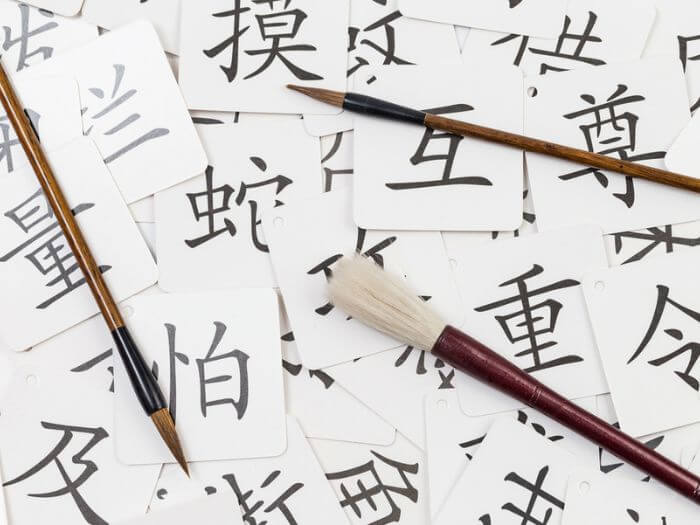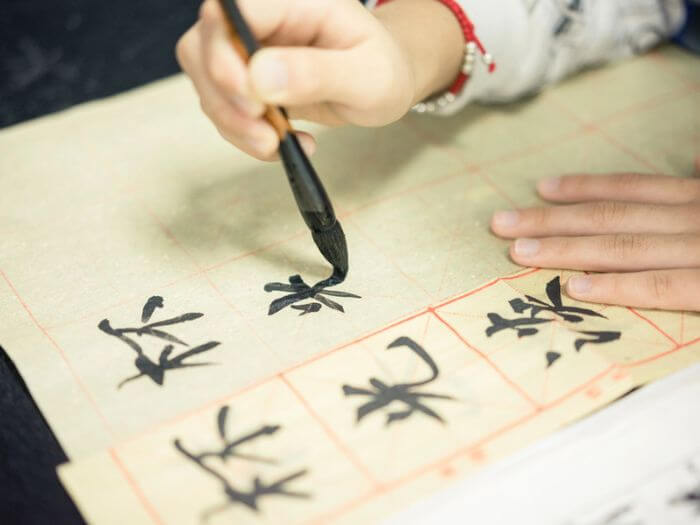
When you think of the Chinese language, you invariably picture the arcane and seemingly impenetrable symbols of its writing. And so strong is the association between the language and its script that sometimes we can forget that Chinese is just a language like any other.
Without the writing, it probably wouldn’t have nearly the same reputation as such a fiendishly difficult language to learn. But the fact is, if you want to learn Chinese properly, characters are something you’re going to have to tackle.
In this post, I’ll deal specifically with the handwritten form of the language to give you an idea of the cultural significance of Chinese script. And to help you decide whether it's worth learning to write characters yourself.
Pro Tip
By the way, if you want to learn Chinese fast and have fun, my top recommendation is Chinese Uncovered which teaches you through StoryLearning®.
With Chinese Uncovered you’ll use my unique StoryLearning® method to learn Chinese through story… not rules. It’s as fun as it is effective.
If you’re ready to get started, click here for a 7-day FREE trial.
Table of Contents
5 Reasons To Learn Chinese Handwriting

If you've started learning Chinese, you will already be familiar with pinyin. And you may wonder, since there is a system for writing Chinese that doesn’t require years of practice to master, if it’s worth bothering with characters.
The answer is, unless all you hope to do is learn a few phrases, then yes you do.
Although most Chinese native speakers use pinyin to type in Chinese, they will usually find it difficult to read a pinyin text. So if you want to communicate via email, chat apps or almost any other digital medium, you will need to learn the writing.
Plus, you'll rarely find texts in pinyin outside the classroom. So if you ever hope to read anything in Chinese – from menus in restaurants to newspapers, magazines and even Chinese novels – you’ll need to become literate in Chinese characters.
The next question people looking for a shortcut might ask is whether you need to learn to write Chinese characters by hand.
It’s true that in modern China – just like everywhere else – people write by hand less and less. And if you do learn to write characters by hand, it's not a skill that you are likely to use very often in your daily life.
However, there are still several compelling reasons why you should take the time to learn to write Chinese characters. 5 in fact.
#1 For Homework And Exams In Chinese
If you take a Chinese class, you'll learn to write characters. And as early as possible, you'll be expected to use them for simple writing exercises and homework.
Also, if you plan to obtain certification for your Chinese, you will need to write in characters when you take Chinese exams.
That said, a computer-based version of HSK (Chinese Proficiency Test) now exists that allows you to type rather than write characters. So perhaps learning to write characters for exams is no longer as important as it once was.
#2 It Will Help You Read Other People’s Handwriting

Another reason to learn how to write Chinese characters is that it will help you understand what other people write.
When you learnt to read and write in English, you started by writing each letter individually before progressing to joined-up writing.
There is a big difference between printed letters and cursive handwriting. And the same is true in Chinese. Chinese people don’t always write every character out carefully and neatly. They write quickly in a character version of joined-up writing.
Even if you can read printed characters, you will probably be completely lost when you see cursive Chinese handwriting, for example, on hand-written signs in the street. And some Chinese people have terrible handwriting, just the same as everywhere else!
It is only by handwriting Chinese characters – and possibly even becoming proficient enough to write in cursive script like native speakers yourself – that you will be able to make sense of everyday Chinese handwriting.
#3 Learn Chinese Handwriting For Completeness
What you hope to achieve in Chinese will determine whether you think it’s worth spending the time to learn to write characters by hand. But if you want to achieve a respectable level, you should learn to write the script for the sake of completeness.
Imagine learning a European language like French or German to a reasonably high level but not being able to write even the simplest things – like a message in a birthday card or an address on a parcel – by hand.
If you decide not to learn to write Chinese characters, this is the kind of handicap you are giving yourself. And if you can’t write even basic words, can you really say that you know the language?
If you hope one day to be able to say you are “fluent” in Chinese, would you not feel like a fraud claiming a high level in the language while being totally unable to write?
#4 Writing Chinese Is Enjoyable And Satisfying

At the same time, don’t imagine that learning Chinese characters will entail endless hours of boredom and torture as you copy them out hundreds of times.
Many people who learn to write characters discover that it’s actually highly enjoyable and even therapeutic. And when you sit down to practise, you’ll probably find that the time passes much faster than you realise.
Nowadays, in our high-speed modern world where we want everything right now and attention spans are growing ever shorter, there’s a lot to be said for taking the time to learn a skill that requires patience and dedication.
Slowly and steadily increasing your stock of characters day by day is an extremely rewarding process. And if you’re looking for shortcuts and instant results, learning Chinese is probably not the right choice for you anyway.
#5 Writing Helps You Remember
If none of my arguments so far have convinced you that it’s worth taking the time to learn handwriting in Chinese, then perhaps this last one will.
Chinese characters are not simply a collection of random ideograms. And there is a logic behind the system.
Each character is made up of different elements, all of which have meanings. And it is only by becoming intimately familiar with them by writing them that you can grasp this underlying logic.
In addition, you must write each character in a very specific order, writing each stroke in the correct direction. By writing in Chinese, you build your muscle memory to the point where you can read and write each character without thinking, much as you do when you write using the Roman alphabet.
It might be possible to learn to read without writing. But by far the best way to learn to both read and write is the old-fashioned way. And that means sitting at your desk and practising.
A Short History of Chinese Handwriting

The Chinese language and its writing system are inseparable. And it’s almost impossible to imagine Chinese without characters.
The possibility of switching to pinyin, China’s official system of romanisation, was briefly entertained in the 1950s but was rejected since Chinese characters have far too much cultural significance for them to ever be replaced.
The Chinese writing system is among the oldest – if not the oldest – writing system still in use today, something the Chinese are both aware of and extremely proud about. We have evidence that Chinese characters were in use at least 3,500 years ago. But they probably already existed in some form long before that.
From around the 2nd century CE, characters became standardised. And they changed little over the subsequent two millennia until the reform of the 1950s when 2,000 common characters were simplified in an attempt to increase literacy.
These simplified characters, known as 简体字 jiăntĭzì, are the ones you will almost certainly learn if you study Chinese – unless you study in Taiwan, where traditional Chinese characters, 繁体字 făntĭzì, are still in use. You'll also see traditional characters in Hong Kong and Macau.
How To Learn Chinese Handwriting

There’s no escaping the fact that you’ll need to spend lots of time working on characters in the time-honoured and traditional way. But there are also a couple of modern tools that can help you.
Chinese children learn characters by copying them out many times onto squared paper. And you should start by obtaining some of the special notebooks they use.
After this, just like anything in language learning, the key is constant practice. If you write out a character 100 times today and then never think about it again until next month, the chances are, you won’t be able to remember it.
After six months without practice, you will forget even the most common characters. And even Chinese people who move abroad gradually forget how to write them if they don’t use them.
Practise Daily
This means you should always keep practising, using them every day as much as you can. If you are taking classes, writing short compositions in Chinese will help. But if you're learning by yourself, make sure you write by hand as much as possible.
For example, if you write down vocabulary or take notes, make a point of writing in characters. Don’t allow yourself to be lazy and fall back into pinyin. This kind of self-discipline will allow you to retain the thousands of characters you need to become literate in Chinese.
Use An App
One highly recommended learning aid is the Skritter app, which helps you learn to write and remember new characters as well as recycling old ones you already know. There’s a subscription fee, but if you’re serious about your Chinese, it’s well worth the money.
Draw Characters On Your Phone
Another tip is to switch the input method on your phone to the hand-written version so that instead of typing characters in pinyin, you draw each one by hand.
It may take longer at the beginning – and to be honest, not many learners actually do it. But if you persevere, this is an excellent way to help you retain the characters you already know by practising them every day.
Chinese Calligraphy

It’s also worth saying a quick word about Chinese calligraphy since it occupies an extremely important place in Chinese culture.
As I mentioned at the start, the Chinese language is inseparable from its script. And there's perhaps no other language in the world whose writing system has such a deep cultural significance.
While as a purely spoken language, Chinese may be no more or less special, unique, interesting or remarkable than any other, the undeniably beautiful and evocative way it is written sets it apart.
In China, calligraphy is regarded as the highest form of art. And the most accomplished calligraphers are counted among China’s greatest artists.
However, fine calligraphy is quite distinct from simply being able to write characters with a ballpoint pen. And you don’t need to study calligraphy to master Chinese writing.
Chinese calligraphy is traditionally done with a paintbrush. And becoming skilled in it requires a good teacher and many years of practice. You will probably spend hours just working on characters as simple as 一 yī, the Chinese character for “one”!
However, if you are interested in trying, many Chinese schools also offer introductory calligraphy courses.
To gain an understanding of the esteem in which calligraphy is held in Chinese culture, the Shanghai Museum in People’s Square, Shanghai, and the National Taiwan Museum in Taipei both contain extensive collections of some of the finest Chinese calligraphy by many famous calligraphers.
FAQs About Chinese Handwriting
What is the Chinese handwriting called?
Chinese handwriting is commonly referred to as Chinese calligraphy (书法, shūfǎ). It is considered an art form that involves the careful and stylistic writing of Chinese characters.
Traditional Chinese calligraphy uses brushes and ink, and there are various styles such as Kaishu (regular script), Xingshu (semi-cursive script), and Caoshu (cursive script), each with unique characteristics and techniques.
For everyday writing, however, people usually use simplified handwriting styles with pens or pencils, but calligraphy remains a respected cultural and artistic practice.
How to do Chinese handwriting?
To start practising Chinese handwriting, especially traditional calligraphy, follow these steps:
Get Basic Materials: You’ll need a brush (or calligraphy pen), ink, and paper (such as rice paper for authentic practice or regular paper if starting with a pen).
Learn Basic Strokes: Chinese characters are built from a set of basic strokes, like horizontal (横, héng), vertical (竖, shù), and dot (点, diǎn). Practise these strokes as a foundation for forming characters.
Follow Stroke Order: Chinese characters are written in a specific order, typically starting from top to bottom and left to right. Following the stroke order helps characters look balanced and is essential for learning correct handwriting.
Choose a Script Style: Beginners usually start with Kaishu (regular script) because it’s more structured and easier to read. As you advance, you can explore Xingshu (semi-cursive) or Caoshu (cursive) for more expressive styles.
Practise Consistently: Write each character slowly, focusing on uniformity and balance. Practising grids can help you maintain the proportions of each character.
Use Tracing Sheets: Many learners use tracing sheets or guides with outlined characters to improve form and control before writing freehand.
With regular practice, you’ll develop a feel for the rhythm and balance in Chinese characters, whether for casual handwriting or more formal calligraphy styles.
How to identify Chinese writing?
To identify Chinese writing, here are some key features that distinguish it from other scripts, especially other East Asian languages:
Character Structure: Chinese writing uses logograms—each character represents a word or idea rather than a sound. Characters are generally square-shaped and made up of individual strokes.
Absence of Alphabetic Symbols: Unlike languages with alphabets, Chinese characters are complex symbols without separate letters. Each character is a unique combination of radicals and strokes, without spaces between characters within sentences.
Look for Radicals: Many characters share common radicals (basic components) that provide clues to meaning or pronunciation. Some common radicals include those for water (氵), person (亻), and heart (忄). This can help distinguish Chinese characters from similar-looking ones in Japanese or Korean.
No Curved Vowel Markers: Chinese characters generally lack the curving, flowing marks found in scripts like Thai or Korean (Hangul). Characters are formed from mostly straight or angled lines, with occasional small dots or hooks.
Simplified vs. Traditional Characters: In Mainland China and Singapore, simplified Chinese characters are used, which have fewer strokes. Traditional Chinese characters, used in Taiwan, Hong Kong, and Macau, are more intricate and often have more strokes. This can help identify regional variants.
If you see writing with these traits, it is likely Chinese. Japanese kanji characters are visually similar but often combined with simpler characters, while Korean writing uses rounded syllable blocks that make it easy to distinguish from Chinese.
How can you tell the difference between Chinese and Korean handwriting?
To distinguish between Chinese and Korean handwriting, look for the following features unique to each script:
Character Shape and Structure:
Chinese: Uses complex, square-shaped characters composed of various strokes that form individual symbols. Each character represents a word or concept. The structure tends to be dense and compact without spaces between characters within sentences.
Korean: Uses syllable blocks composed of simpler shapes (rounded circles, vertical and horizontal lines). Each block represents a syllable, and words are separated by spaces, making the script look more spacious.
Presence of Circles:
Korean characters (Hangul) often contain circles (like “ㅇ”), which are absent in Chinese characters. This distinctive round shape in Korean handwriting is a key indicator.
Simplicity and Composition:
Chinese characters are generally more complex, with intricate strokes, especially in traditional Chinese. Simplified Chinese characters have fewer strokes but still appear denser than Korean.
Korean Hangul is more consistent in simplicity, with characters typically made up of 2–4 components per syllable block, making it appear more uniform.
Spacing Between Characters:
Korean writing includes spaces between words, similar to English. In contrast, Chinese writing typically has no spaces between individual characters, resulting in a continuous flow.
These differences in shapes, spacing, and the presence of round forms make it easy to distinguish Chinese handwriting from Korean.
Chinese Handwriting: A Worthy Pursuit And Time Well Spent

If you have no ambitions in Chinese beyond basic communication and are happy just being able to hold simple conversations, then you can probably get away with not learning to write characters by hand.
However, if you hope to reach a high level of proficiency and see mastering Chinese as a long-term goal, you should see learning to write characters as an integral part of the process rather than an optional extra.
Chinese is a fascinating language to study. And its writing system is an inextricable part of that. Once you start, characters are not particularly difficult to learn. They just require regular practice – and a considerable amount of time.
In many ways, the dedication, determination and self-discipline required to learn to write Chinese characters are what make it so rewarding. And mastering several thousand characters is something that should give you a huge sense of achievement.

Olly Richards
Creator of the StoryLearning® Method
Olly Richards is a renowned polyglot and language learning expert with over 15 years of experience teaching millions through his innovative StoryLearning® method. He is the creator of StoryLearning, one of the world's largest language learning blogs with 500,000+ monthly readers.
Olly has authored 30+ language learning books and courses, including the bestselling "Short Stories" series published by Teach Yourself.
When not developing new teaching methods, Richards practices what he preaches—he speaks 8 languages fluently and continues learning new ones through his own methodology.









































